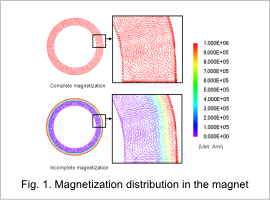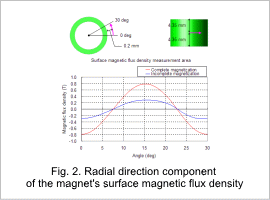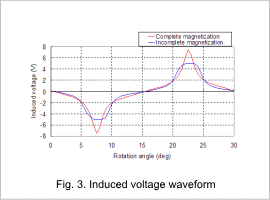Overview

Detailed measurements of the magnetization distribution inside a magnet are difficult to make. However, it is possible to accurately find the magnet’s magnetization because it can be obtained through analysis of the magnetization field from the magnetization device, using the finite element method (FEM).
In this analysis, a magnetization device model is created and a magnet is magnetized. The magnetization distribution and surface magnetic flux density of the magnetized magnet, and the induced voltage of a PM stepper motor with the magnetized magnet integrated into it, are then obtained.
Magnetization Distribution and Surface Magnetic Flux Density of the Magnet
The magnetization distribution of the magnet magnetized by the magnetization device is shown in fig. 1, and fig. 2 shows the radial direction component of a two-pole span of the surface magnetic flux density at 0.2 mm from the magnet surface.
It can be seen from fig. 1 that magnetization is strong in all parts of the magnet under complete magnetization, and magnetization is weak toward the inner side of the magnet under incomplete magnetization. This is why in fig. 2, the maximum surface magnetic flux density value under complete magnetization is around 0.8 T, and is smaller at around 0.3 T under incomplete magnetization. This shows that it is necessary to consider the magnetization ratio and recoil relative permeability in order to grasp the magnetization state.


Induced Voltage Waveform



